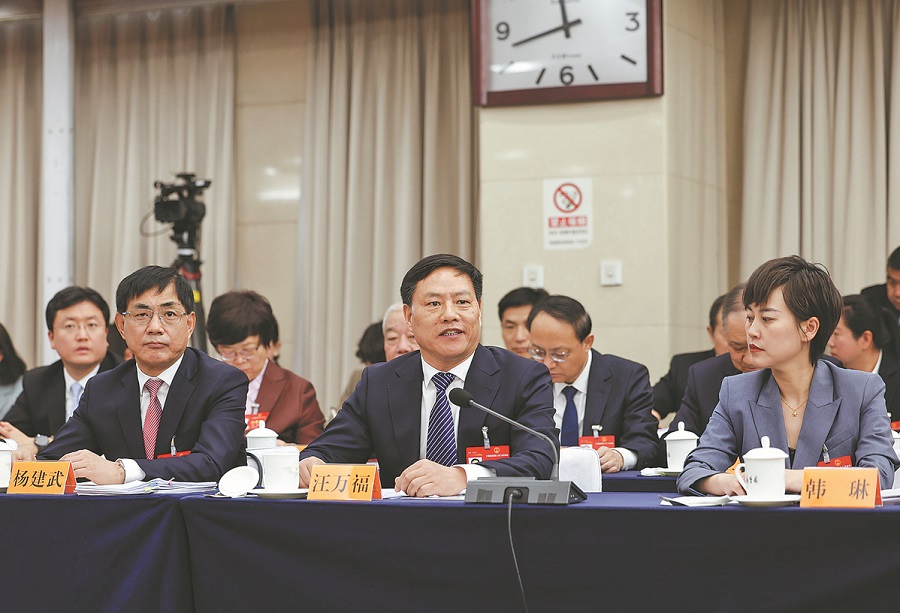Lawmakers briefed on Mogao protection

Wang Wanfu (center) speaks during an open discussion of the Gansu delegation attending the second session of the 14th National People's Congress in Beijing on Sunday. [Photo by Meng Jie/For China Daily]
Gansu province is continuing to enhance the protection of cultural heritage at Dunhuang and promote Dunhuang studies, Wang Wanfu, a deputy to the 14th National People's Congress, said during an open discussion at the two sessions on Sunday.
Wang is also deputy director of the department of conservation and research at the Dunhuang Academy, the institute that oversees the Mogao Caves, a UNESCO World Heritage Site in Dunhuang. The hundreds of Buddhist caves at the site, dating from the fourth to the 14th centuries, feature exquisite murals and statues.
Located on the ancient Silk Road, the site is often seen as a symbol of exchange and mutual learning among various civilizations.
In 2019, when President Xi Jinping visited Mogao Caves, he noted the importance of protecting the site, and urged the building of the Dunhuang Academy into a model of world cultural heritage site protection, and a highland for Dunhuang studies.
"In recent years, we have always kept in mind President Xi's sincere exhortation, regarded implementing the spirit of President Xi's important speeches as the main principle of our work... and achieved progress toward realizing the goal," Wang said.
He said important research platforms have been built for Dunhuang studies. For example, China's first multi-field coupling laboratory in the cultural heritage field has been established in Dunhuang for protecting ancient murals and earthen ruins. It can simulate different environmental conditions and check their influence on cultural heritage.
"As long as no major changes happen in the external environmental conditions, we believe it's possible to make Mogao Caves stand for another 1,000 years with current technological efforts for protection," Wang said.
The academy has also completed the digital recording of 290 caves covering 26,000 square meters and opened the Digital Dunhuang repository, providing high-definition images and panoramic roaming of 30 caves to a global audience, Wang said.
"In the 1990s, Fan Jinshi, then executive deputy director of the Dunhuang Academy, proposed protecting endangered cultural relics with digital measures," Wang said. After 30 years of exploration and development, the academy has formed a complete set of procedures and equipment systems for the digitization of murals in cave temples, he added.
With their high-level protection experience and skills, researchers at Dunhuang Academy have also been invited to participate in more than 60 domestic cultural relics protection projects and offered technical support for countries involved in the Belt and Road Initiative like Kyrgyzstan and Myanmar, he said.
In recent years, scholars have continued to improve the system of Dunhuang studies, and published more than 90 academic books and 560 essays. More than 50 academic seminars have also been held, promoting Dunhuang culture in the context of the Belt and Road Initiative, Wang said.
More than 150 exhibitions at home and abroad and more than 300 public welfare activities with Dunhuang as their theme have been held in recent years, he said.
"We will enhance technological innovations in cultural relics protection and Dunhuang studies, continue to dig into the value and connotations of Dunhuang culture, and promote creative transformation and innovative development of the cultural heritage," Wang said.
"We will continue to build the Dunhuang Academy into a model of world cultural heritage protection and a highland for Dunhuang studies, and contribute to building China's cultural strength and adding new luster to Chinese culture."
- Top legislature schedules session for December
- China's top legislator holds talks with president of Luxembourg parliament
- China's top legislator meets with French president
- China, Maldives pledge to enhance exchanges between legislative bodies
- Senior Chinese legislator meets Portugal's PSD delegation



